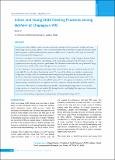Please use this identifier to cite or link to this item:
https://hdl.handle.net/20.500.14356/1711| Title: | Infant and Young Child Feeding Practices among Mothers at Chapagaun VDC |
| Authors: | Basnet, D |
| Citation: | BasnetD. (2016). Infant and Young Child Feeding Practices among Mothers at Chapagaun VDC. Journal of Nepal Health Research Council, 14(2). https://doi.org/10.33314/jnhrc.v14i2.800 |
| Issue Date: | 2016 |
| Publisher: | Nepal Health Research Council |
| Article Type: | Original Article |
| Keywords: | Breastfeeding Complementary feeding Infant and Young child Feeding PHCRC |
| Series/Report no.: | May-Aug, 2016;800 |
| Abstract: | Abstract Background: Since childhood under nutrition and mortality are high in Nepal, promotion of infant and young child feeding practices among children is most critical intervention,which contributes to improved nutrition, health and development of children ultimately having impact on child survival. The objective of the study was to identify infant and young child feeding practices. Methods: A descriptive cross-sectional study was carried out among mothers visiting Chapagaun Primary Health Care and Resource Centre (PHCRC) with child aged 6-23 months between January1-14, 2016. Interview of 62 respondents was done by using structured questionnaire. The obtained data was analyzed by using Statistical Package for Social Sciences (SPSS) version 20 and Chi square test was performed. Results: Majority (72.6%) initiated breastfeeding within 1 hour of delivery and gave colostrum as the first feed to the child. The rate of exclusive breastfeeding was 61.3%. Some of the children were initiated complementary feeding after 6 months, while 58% mothers practiced complementary feeding after the recommended age and 38.6% even before the recommended age. One fifth of the children received dietary diverse meal. Only 12.9% received complementary food with recommended frequency, 40.3% with appropriate consistency and 12.9% with adequate amount. Statistically there was significant association of practice with age of mother and mode of delivery. Conclusions: The practice of breastfeeding was good while complementary feeding practices were poor. The feeding practices were found to be sub-optimal. The findings from the study highlight the importance of education at immunization clinic in order to improve the practices. Keywords: Breastfeeding; complementary feeding; Infant and Young child; feeding; PHCRC. |
| Description: | Original Article |
| URI: | http://103.69.126.140:8080/handle/20.500.14356/1711 |
| ISSN: | Print ISSN: 1727-5482; Online ISSN: 1999-6217 |
| Appears in Collections: | Vol. 14 No. 2 Issue 33 May-Aug 2016 |
Files in This Item:
| File | Description | Size | Format | |
|---|---|---|---|---|
| 800-Article Text-1478-2-10-20170528.pdf | Fulltext Download | 189.52 kB | Adobe PDF |  View/Open |
Items in DSpace are protected by copyright, with all rights reserved, unless otherwise indicated.
